Leaf Feeders
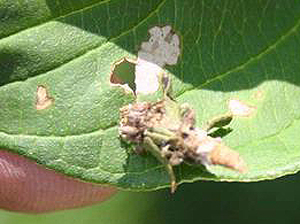
William Fountain, University of Kentucky, Bugwood.org
Bagworms are caterpillars that live in distinctive spindle-shaped silk bags covered with small bits of leaves from the host plant. Large populations of bagworms can strip plants of their foliage and eventually cause them to die. Infestations often go unnoticed because people mistake the protective bags for pine cones or other plant structures. For more information, see Entfact 440.
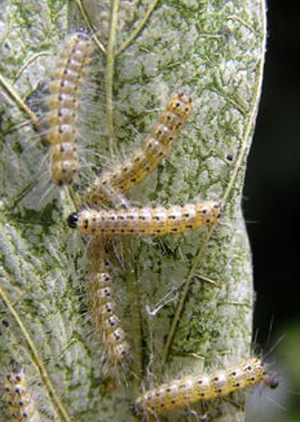
Milan Zubrik, Forest Research Institute - Slovakia, Bugwood.org
Fall webworms are small hairy white caterpillars that live communally in thin silken webs at the ends of branches. They may leave the tent to feed individually as they get larger. While the webbing is unsightly, feeding damage is usually limited to limbs around the tent. Large established trees are not seriously affected by small to moderate infestations. The larval stage feeds for 4 to 8 weeks and may be found on a variety of hardwoods. The first generation occurs in late May and early June, the second generation is usually larger and active from July through September. For more information, see Entfact 424
Sap Feeders
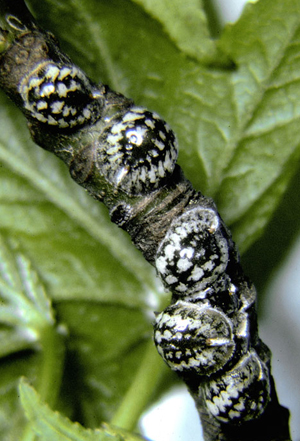
Raymond Gill, California Department of Food and Agriculture, Bugwood.org
Calico scale is a white and dark brown soft scale about 1/4 inch in diameter. It produces a large amount of honeydew in the spring so twigs, branches, and leaves may be covered with sooty mold. This scale can severely weaken trees, making them more vulnerable to drought and other stresses. Egg hatch occurs in May and the crawlers move to leaves to feed for the summer. Nymphs move back to bark for the winter.
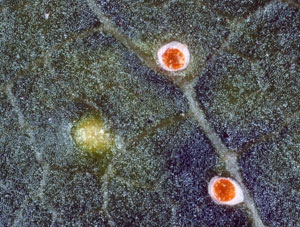
J.A. Davidson, Univ. Md, College Pk, Bugwood.org
Sweetgum scale occurs on twigs, branches, and lower surfaces of leaves. These small yellow scales can be found in pits on the underside of leaves. The crawlers are active during May and June and again in August.
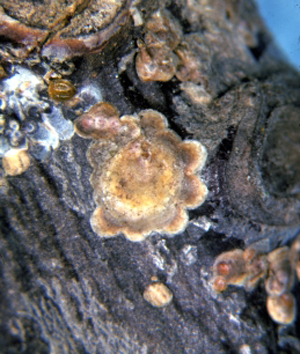
Raymond Gill, California Department of Food and Agriculture, Bugwood.org
Walnut scales are 1/8 inch long nearly circular, flat scales that are gray with a reddish brown spot. Crawlers are active in mid June and in late August to early September in Kentucky. For more information, see Entfact 436.
Borers
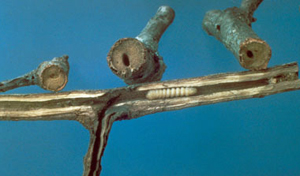
James Solomon, USDA Forest Service, Bugwood.org
Twig pruners are the larvae of small beetles that tunnel in twigs and small branches. Female beetles lay their eggs about the time of bud break in the spring. Eggs are laid in small holes which are chewed into the bark. The larvae that hatch from these eggs bore into and tunnel toward the base of twigs. In late summer, they chew concentric circles outward toward the bark then move toward the tip. The twig eventually snaps and falls to the ground. The larva pupates in the fallen twig and emerges as an adult in the spring. Collecting and destroying fallen twigs can help to reduce infestations.
Root Feeders
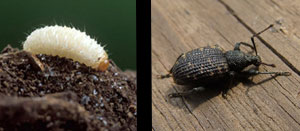
grub: Peggy Greb, USDA Agricultural Research Service, Bugwood.org ;
adult: Cheryl Moorehead, Bugwood.org
Black vine weevil grubs are white legless larvae with yellow brown or red heads that live in the soil and feed on plant roots. Moderate root feeding may cause plants to show signs of drought stress. Girdling can occur and nutrient transmission is disrupted, occasionally leading to death of the plant. The adults (0.5 inch long) are dark snout beetles that may chew crescent-shaped holes in leaves while feeding at night. Normally there is one generation per year with the larva overwintering. Pupation and adult emergence occurs in the spring. Sometimes adults may overwinter which can result in damage occurring from larvae earlier in the season.